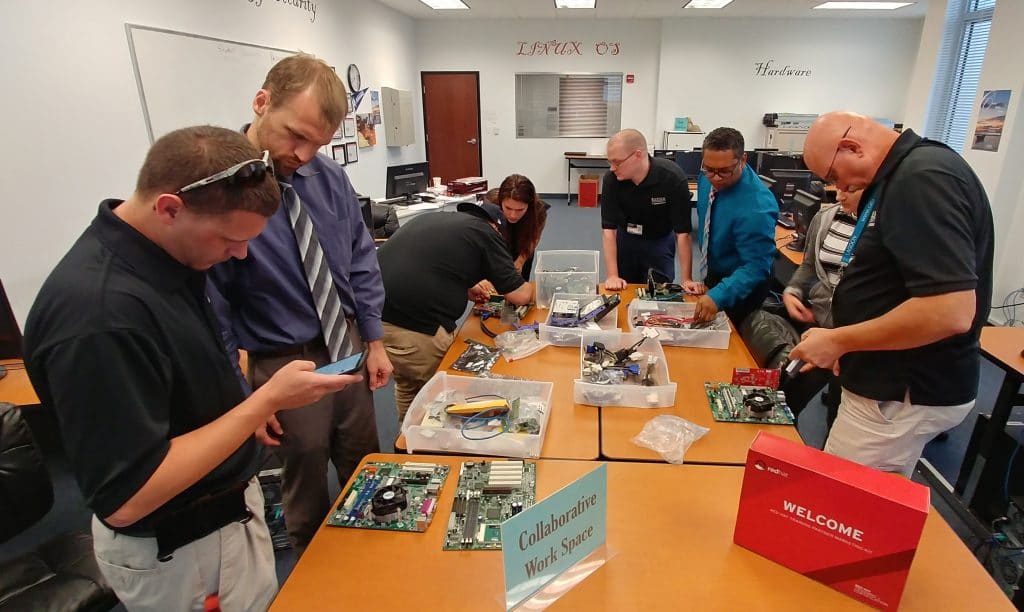Today's workforce is grappling with two major challenges: a critical shortage of skilled workers and the rapid pace of technological change. Trade schools have stepped up as key talent pipelines by partnering directly with employers. These collaborations combine classroom instruction with hands-on industry expertise, producing graduates who are job-ready from their first day. Students get the theory they need while learning from professionals who understand what really works in the field.
Let's look how these strategic partnerships create opportunities for students while delivering tangible results for businesses that need skilled talent now.

Section 1: What Makes Trade School Partnerships Work
Successful partnerships thrive on three pillars: relevant training, real-world experience, and shared resources.
Industry Input Shapes Classroom Learning
Employers don’t just advise, they create with you. Advisory boards with professionals like engineers and project managers ensure programs teach up-to-date skills. For example, welding programs added robotics modules after manufacturers emphasized automation needs 1. This teamwork keeps training aligned with employer demands.
Learning by Doing
Apprenticeships and internships bridge theory and practice. An HVAC program in Texas saw a 25% jump in qualified hires after partnering with local contractors to offer hands-on training.

Students troubleshoot real equipment and build relationships with potential employers long before graduation.
Tools That Mirror the Workplace
Modern equipment is expensive, but industry donations solve this gap. Airlines donate retired planes to aviation programs, letting students master cockpit systems used in actual fleets 2. These contributions ensure learners train on the same tools they’ll use at work.
Section 2: How Partnerships Drive Job Placement
Trade school programs with strong industry ties achieve job placement rates above 90% in fields like manufacturing and healthcare 3. Three strategies make this possible.
Apprenticeships: The Ultimate Audition
When Finger Lakes Community College partnered with manufacturers, 86% of apprentices became full-time employees after proving their skills on-site 3. Employers reduce hiring risks, while students secure roles before graduation.
Tech Tools Match Skills to Jobs
Student Information Systems (SIS) now use data to connect graduates with openings. For example, schools tag students’ certifications (like OSHA-30 safety training) in databases employers can search, cutting hiring time by 40% in some cases 5.
Alumni Become Advocates
Graduates often return to hire classmates. A Texas automotive program credits 30% of its annual job placements to alumni referrals, creating a self-sustaining hiring cycle 6.
Section 3: Keeping Programs Ahead of Industry Shifts
Trade schools stay relevant by treating employers as co-teachers.

Certifications That Open Doors
When Miami construction firms needed more sustainability experts, a local trade school partnered with the U.S. Green Building Council. Graduates now earn dual credentials in LEAD certification, making them top candidates for eco-conscious contractors.
Professionals as Educators
Cisco engineers teach networking courses, while master electricians lead code-compliance workshops.
“Students learn tricks you won’t find in textbooks,”
says a welding instructor whose classes feature weekly demos from shipyard veterans 7.
Adapting at Warp Speed
When electric vehicle demand surged, Michigan trade schools collaborated with Tesla to launch battery repair courses in under two months.
“We rebuilt our electrical curriculum faster than I thought possible,”
notes instructor Marco Torres 8.
Section 4: Why Businesses Invest in Trade School Programs
The ROI for companies is clear—but schools benefit too.
Lower Costs, Better Retention
Employers report 52% lower training costs for graduates of partnered programs 9.
A Wisconsin machining firm cut onboarding from 12 weeks to 3 after co-designing a CNC operator course tailored to their machines.
Schools Gain Enrollment and Resources
Programs with hiring guarantees see 28% higher enrollment 10. Partnerships also fund scholarships and facilities, like Trane Technologies’ $2 million investment in HVAC training labs.
Solving Partnership Challenges
Safety concerns once limited under-18 apprenticeships, but VR simulations now let minors practice welding or electrical work risk-free.
“The virtual lab gives real experience without liability issues,”
explains a Kansas trade school director.

Section 5: Tracking Outcomes That Matter
Schools measure success through:
- 90-Day Hire Rates: 89% for partnered programs vs. 67% for others 11
- Employer Satisfaction: 82% rate graduates “job-ready” compared to 58% for non-partnered peers 12
- Long-Term Earnings: Graduates from collaborative programs earn 19% more within five years 13
Section 6: Real-World Success Stories
- Louisiana’s Autism-to-Work Initiative: Baton Rouge Community College partners with the state transportation department to train students with autism for infrastructure roles.
“The program showed me I could thrive in engineering,”
says graduate Emily Sorrel, now a full-time CAD technician 14.
- Trane’s Fast-Track Apprenticeships: Their 90-day HVAC training model supplies 30% of the company’s Midwest technicians, with graduates earning certifications while on payroll 15.
Building a Workforce Together
Trade school programs and employers aren’t just filling jobs, they’re building careers. When students pick schools with strong industry connections, they're setting themselves up for roles where their skills really count. For businesses, these partnerships slash hiring costs while bringing in talent that tends to stick around. As technology keeps changing the game, these collaborations are going to be what separates the companies that thrive from the ones that struggle to keep up. The message is clear: Invest in partnerships today, or scramble for skilled workers tomorrow.



